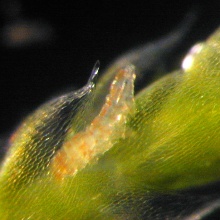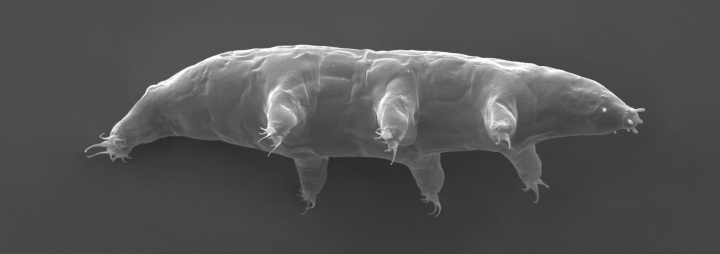A new tardigrade species was discovered by Dr. Ralph Schill from the Institute of Biomaterials and Biomolecular Systems (IBBS) at the University of Stuttgart. The species is now known as Milnesium inceptum, derived from the Latin term for pioneer or initiator. At the same time, Schill, together with colleagues from England, Poland and Japan, classified another tardigrade species as a neotype: Milnesium alpigenum, which had already been described in the middle of the 19th century but was no longer present as a preserved specimen.
Tardigrades are survivalists. They occur in a wide variety of habitats and have the ability to survive long periods of time in a resting stage, in which they wait for better environmental conditions and have no detectable metabolism. For this reason, a steadily growing number of scientists are interested in these fascinating animals. One of the first species ever described was Milnesium tardigradum, which was named by the French zoologist Louis Michel François Doyère in the first half of the 19th century. 13 years later, German zoologist Christian Gottfried Ehrenberg described another species: Milnesium alpigenum, which was initially found in the Monte Rosa massif in the Pennine Alps on the border between Italy and Switzerland. In 2003, zoologist Ralph Schill came to the University of Stuttgart with his own animal culture of “Milnesium tardigradum Doyère 1840“, which had been found in the Schönbuch nature reserve. Using this species as a model organism, he established one of the most prestigious tardigrade research groups in the world. Between 2003 and 2016, more than 30 scientific papers were published. The world's largest tardigrade project, “FUNCRYPTA”, was funded by the Federal Ministry of Education and Research (BMBF).
Scientists find new species
The decisive factor for a species description is the comparison with the so-called holotype, the animal which was used for the first description. Since both the Doyère and the Ehrenberg specimens no longer exist, so-called neotypes were defined, preserved specimens which instead represent the respective species and serve as reference material. Molecular information, such as DNA sequences, have been added to the morphological characteristics used so far. When comparing many specimens of the Milnesium tardigradum species from different regions of the world, zoologists found that both the Stuttgart specimens and those of a Japanese scientist must belong to a new species. As a result, a Milnesium species was redescribed as a new neotype of the no longer existing species Milnesium alpigenum, and the Stuttgart tardigrades were introduced to science as a new species, Milnesium inceptum. The name of the new species comes from the Latin “inceptor”, which means “an initiator” or “a pioneer”, after Ralph Schill had established this species as a new model organism in tardigrade research.
“It's exciting to speak of a new species that you've actually been working with for over a decade,” says Schill. For everyday life in the laboratory and for the animals, however, the new scientific name is not so important. It's a little more difficult for the colleagues, who are confronted with a new name when the old name can be found in many publications. “It's like getting married and getting a new surname,” the scientist says with a chuckle: “At first it's a bit odd, but soon everybody will get used to it.“
New standard work on the little water bears published
In collaboration with 25 leading tardigrade researchers, Schill has now published a standard book “Water Bears: The Biology of Tardigrades“. For the first time, it contains a complete description of the first almost two hundred years of tardigrade research. The 400-page book, with 51 black and white illustrations and 65 colored illustrations, documents the discovery of the animals and the first description in 1773, up to current scientific knowledge on the morphology, taxonomy, phylogeny, biogeography, paleontology, cytology and cytogenetics of tardigrades. The book provides insight into the ecology of the tardigrades, which can occur in the sea, in lakes and rivers and in terrestrial habitats. Other chapters give an overview of their reproduction, development and life cycles, as well as the exceptional environmental adaptations, such as drought and freezing tolerance, for which the animals are known. The latest molecular techniques used in tardigrade research as well as practical tips for sampling and sample processing are also described. The book concludes with a complete overview of the tardigrade groups known so far.
Expert Contact:
Prof. apl. Ralph O. Schill, Institute of Biomaterials and Biomolecular Systems (IBBS), Pfaffenwaldring 57, 70569 Stuttgart, phone: +49 (0)172 7304726, mail
Original publication:
Morek et. al 2019. Redescription of Milnesium alpigenum Ehrenberg, 1853 (Tardigrada: Apochela) and a description of Milnesium inceptum sp. nov., a tardigrade laboratory model. Zootaxa 4586 (1): 035-064
https://doi.org/10.11646/zootaxa.4586.1.2 (open access)
“Water Bears: The Biology of Tardigrades“, Springer Verlag, 2018
419 pages, 118 illustrations, ISBN 978-3-319-95702-9



